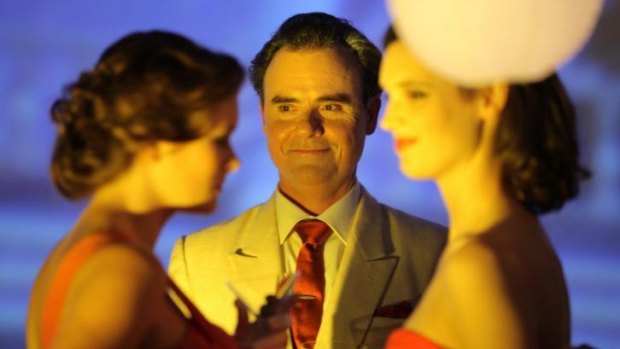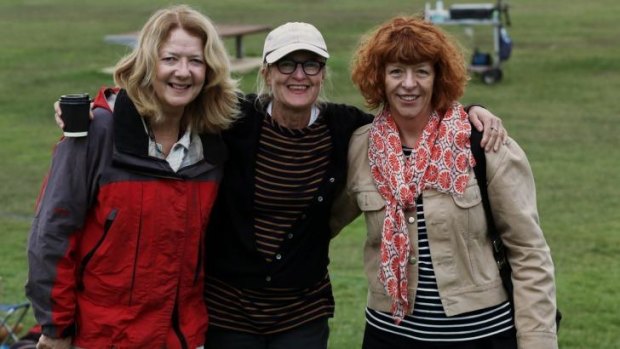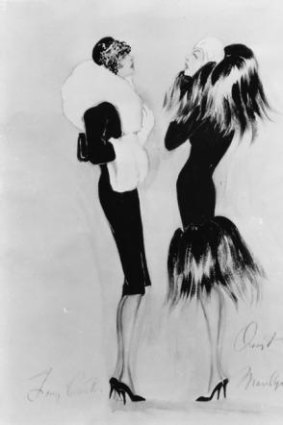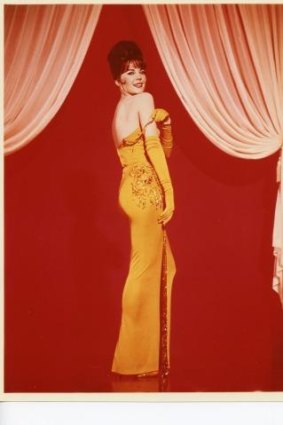This was published 8 years ago
Women He's Undressed: Gillian Armstrong tells the story of fashion designer Orry-Kelly
By Jane Freebury
The story of Orry-Kelly, a gifted designer who created costumes for the Hollywood stars over three decades, would be tantalising fantasy were it not anchored in fact.
Here's this young man from Kiama on the south coast town of NSW who leaves for America in 1922, never to return, or at least only for visits. He makes the long sea and land journey to New York and works on Broadway for a while. Then he moves to Hollywood where he chalks up credits in more than 285 movies along with three Oscars, for costume design in Some Like It Hot, Les Girls and An American in Paris. He was the most successful Australian in Academy Award history until costume and production designer, Catherine Martin, won her third and fourth Oscars last year for her work on The Great Gatsby. As thumbnails go, this is hard to beat.

Orry-Kelly played by Darren Gilshenan with cocktail party guests.Credit: Anna Howard
The Orry-Kelly story is incredible, and someone had to tell it. Fortunately, a highly-regarded Australian filmmaker has made it the subject of her lively new documentary, Women He's Undressed.
Film director Gillian Armstrong has been in the public eye since she directed emerging actors Judy Davis and Sam Neill in My Brilliant Career in 1979. She was the first women to direct a feature film in Australia in over 40 years. Other fiction features include Oscar and Lucinda, The Last Days of Chez Nous and Little Women, films with some of the finest female actors in the frame. In between, Armstrong has also directed well-received documentaries like the candid series, similar in conception to Michael Apted's Seven Up, that has followed the lives of three Adelaide women since they were 14 years old.

Director Gillian Armstrong with writer Katherine Thomson and line-producer Catherine Flannery.Credit: Prudence Upton
Although Armstrong is associated with films that focus on women, an impression has lingered since early work based on books by feminist writers, that she does resist. She prefers to characterise her interest as relationships between people. "I would always say that I'm really interested in human behaviour," she says in a phoner the week before she's to visit Canberra for a preview and Q&A.
Orry-Kelly is a fascinating subject for a director who explores relationships. He was famously and outrageously frank, mercurial, funny, uncompromising, held in high professional regard, and on intimate terms with many of the celebrities of yesteryear. Was he a celebrity in his own right in Australia too, in his day? "Oh my goodness, he was huge! They interviewed him like they would Hugh Jackman."
Research for the doco turned up a great deal of fascinating material, including correspondence and a newspaper column he wrote. "Also we found other articles, you know, occasionally in the Sydney Morning Herald. We think his mother wrote to the editor letting everyone know what he was currently doing. That's how we got the idea that his mother was very important in his life, and enjoyed promoting her son."
Women He's Undressed includes a dramatisation that threads its way through the rich vein of interviews with scenes between letter-writer Orry-Kelly (Darren Gilshenan) in America and his mum back home in Kiama (Deborah Kennedy). Armstrong collaborated with playwright and "co-conspirator' Katherine Thomson on these cheeky, quirky interludes.

Some Like It Hot.
Orry-Kelly, a kid from Kiama, dressed the stars at the height of the studio system in Hollywood 1930s-1950s. Actors like Marilyn Monroe, Bette Davis, Natalie Wood, Barbara Stanwyck, Ingrid Bergman, Shirley MacLaine, and Angela Lansbury and the young Natalie Wood and Jane Fonda, early in their careers frocked up in his creations. There is some great footage of Fonda and Lansbury here, along with a wealth of interviews with other designers, industry observers and costume design experts (like the wonderful Deborah Nadoolman Landis), interwoven with extracts from the films that feature the costumes, they are a trove of movie history in themselves.
Catherine Martin appears. She has also had an incredible career. Will someone make a doco about her? And other costume designers working in the international film industry appear like Michael Wilkinson, another Australian, whose credits include 300 and American Hustle.

Natalie Wood in Gypsey Women He's Undressed. Sydney Film Festival
Although he passed away in 1964, Orry-Kelly is still remembered in the US, says Armstrong. "In America he's still very well known" – still regarded today as one of the top costume designers of all time – "but a lot of people don't realise he's Australian". However, "he did have a big mouth". Armstrong thinks his sense of humour – Australian humour is not readily understood overseas, much less in the middle of last century – got him into trouble from time to time, as he was a bit of a loud mouth when he drank.
Why was he hired by Warner Brothers early in the 1930s, the studio with a reputation for making gritty gangster films, and not by MGM with its fondness for lavish production? "Well they had a complete change when Jack Warner poached three new leading ladies (one of whom was Barbara Stanwyck). They weren't just going to be doing gangster stories [and] Jack Warner wanted his new designer to bring class."
What was the hallmark of an Orry-Kelly gown? "The first thing people think of when they think 'costume' is frills and fuss, but Orry-Kelly had a really great sense of line and style. His costumes were about telling the story, what would this character really wear.[...] Other studios just wanted their leading ladies to walk in (dressed) in the latest fashion."
"For other designers who came from fashion it was about the frock, making the frock stand out. Orry had a different way of looking at things," says Armstrong.
Orry-Kelly moved with the times, from his designs for Busby Berkeley's 42nd Street in 1933 to the classic simplicity of the clothes he put on the young Jane Fonda in the 1960s. "He also had a great sense of humour and could do completely over the top. He could push design if he needed to and pull it back as well."
His work is enshrined in so many Hollywood classics, from Jezebel and Dark Victory in black and white to Irma la Douce and Oklahoma in vivid technicolour, but Orry-Kelly can be equally well remembered for one of the greatest of all time. "He did beautiful work on Casablanca, where Ingrid Bergman's clothes were so understated but they said so much about her character. That she had such inner strength and integrity."
A preview screening of Women He's Undressed at Palace Cinema in Canberra on Wednesday July 8 at 7 pm will be followed by a Q&A with director Gillian Armstrong.